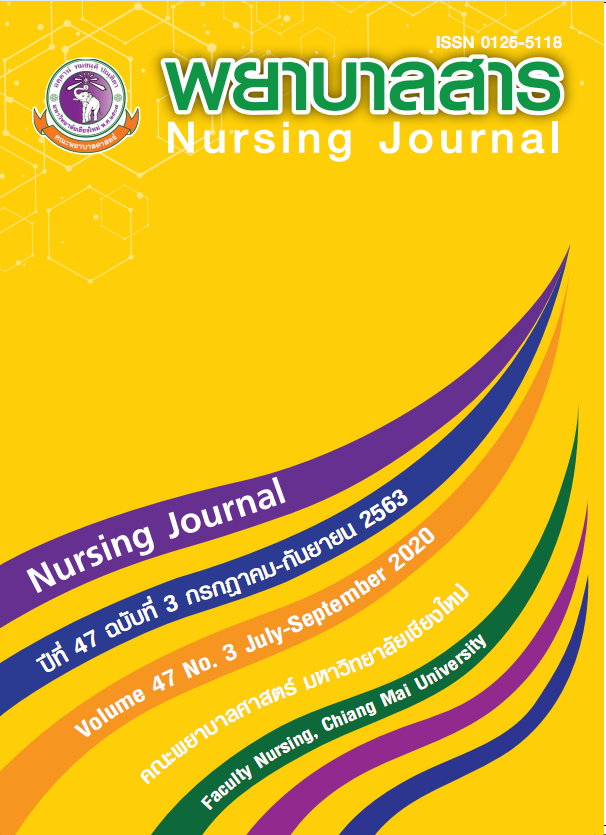Nursing Intervention for Improving Nutritional Status in Older Persons
Keywords:
Older Persons, Improvement of Nutritional Status, NursingAbstract
Malnutrition is a problem found in older persons. Nurses play a crucial role in promoting the older persons to obtain a good nutritional status by screening risk factors or factors related to nutritional status, nutritional assessment and improvement of nutritional status among older persons. Firstly, nurses should screen risk factors or factors related to nutritional status by assessing factor related to the metabolic rate of the older persons and factors related to quantity and type of food consumed. Secondly, nurse should assess nutritional status by concerning with change of aging process and use various methods in nutritional assessment including biochemical assessment, clinical assessment, dietary assessment, anthropometric assessment and body mass index as well as nutritional assessment questionnaire. Finally, with improvement of nutritional status, nurses should apply distinguishing strategies, which depend on potential cause of malnutrition, in order to promote older persons to obtain an appropriate food consumption behavior.
References
Bender, A. E. (2016). Dictionary of nutrition and food technology. London: Elsevier
Bernstein, M., & Munoz, N. (2019). Nutrition for the older adult. Burlington: Jones & Bartlett Learning.
Bleda, M. J., Bolibar, I., Pares, R., & Salva, A. (2002). Reliability of the mini nutritional assessment (MNA) in institutionalized elderly people. The Journal of Nutrition, Health & Aging, 6 (2), 134-137.
Bureau of Nutrition, Ministry of Public Health. (2003). Dietary reference intake for Thais 2003. Retrieved from http://nutrition.anamai.moph.go.th/temp/main/vi ew.php?group=2&id=132 (In Thai)
Cesari, M., P?rez-Zepeda, M. U., & Marzetti, E. (2017). Frailty and multimorbidity: Different ways of thinking about geriatrics. Journal of the American Medical Directors Association, 18 (4), 361-364.
Chumlea, W. C., Guo, S., Roche, A. F., & Steinbaugh, M. L. (1988). Prediction of body weight for the nonambulatory elderly from anthropometry. Journal of the American Dietetic Association, 88 (5), 564-568.
Chumlea, W. C., Roche, A. F., & Steinbaugh, M. L. (1985). Estimating stature from knee height for persons 60 to 90 years of age. Journal of the American Geriatrics Society, 33(2), 116-120. doi:10.1111/j.1532-5415.1985.tb02276.x
Duangjina, T., Panuthai, P., & Suwankruhasn, N. (2017). Food consumption behaviors and nutritional status in dependent older persons. Nursing Journal, 47 (1), 231-241. (In Thai)
Guigoz, Y., Vellas, B. J., & Garry, P. J. (1994). Mini nutritional assessment: A practical assessment tool for grading the nutritional state of elderly patients. Facts and Research in Gerontology, 4 (1), 15-59.
Institute of Geriatric Medicine. (2004). Nutrition assessment guide for elderly. Bangkok: The Agricultural Cooperative Federation of Thailand. (In Thai)
Izaola, O., Mu?oz-Calero, P., & Franco-Lopez, A. (2015). Neurodegenerative diseases; Nutritional aspects. Nutricion Hospitalaria, 32 (2), 946-951.
Jawasit, W., Jitjang, O., & Bunjong, O. (2012). Development of food consumption guidelines for the good nutritional status among elderly (research report). Nakornpathom: Institute of Nutrition, Mahidol University. (In Thai)
National Committee for the Elderly. (2016). Situation of the Thai elderly 2016. Bangkok: Thai Gerontology Research and Development Institute (TGRI). (In Thai )
Nigam, Y., Knight, J., Nigam, Y., & Knight, J. (2016). The anatomy and physiology of ageing 3-the digestive system. Nursing, 10(1), 25-32.
Mahan, L. K., & Raymond, J. L. (2016). Krause's food & the nutrition care process-e-book. Amman: Elsevier Health Sciences.
Mauvais-Jarvis, F. (2015). Sex differences in metabolic homeostasis, diabetes, and obesity. Biology of Sex Differences, 6(1), 14-22.
Piercy, K. L., Troiano, R. P., Ballard, R. M., Carlson, S. A., Fulton, J. E., Galuska, D. A., ... & Olson, R. D. (2018). The physical activity guidelines for Americans. Jama, 320 (19), 2020-2028.
Sauberlich, H. E. (2018). Laboratory tests for the assessment of nutritional status. Boca raton: Routledge.
Steele, C. M., Hanson, B., Lam, P., & Cichero, J. A. (2019). International Dysphagia Diet Standardisation Initiative: Categorization Framework, Labels and Terminology Retrieved from https://ftp.iddsi.org/Documents/Complete_IDDSI_Framework_Final_31July2019.pdf
Thai Health Promotion Foundation. (2012). Overweight and obesity. Retreived from http://www. thaihealth.or.th /Content/20399-overweight and obesity.html
Taylor, C. (2018). Malnutrition: Causes, consequences and solutions. Journal of Community Nursing, 32 (6), 52-60.
Volkert, D., Beck, A. M., Cederholm, T., Cruz-Jentoft, A., Goisser, S., Hooper, L., ... & Sobotka, L. (2019). ESPEN guideline on clinical nutrition and hydration in geriatrics. Clinical Nutrition, 38(1), 10-47.
Wikby, K., Ek, A. C., & Christensson, L. (2006). Nutritional status in elderly people admitted to community residential homes: Comparisons between two cohorts. The Journal of Nutrition, Health & Aging, 10 (3), 232-238.
Downloads
Published
How to Cite
Issue
Section
License
บทความที่ได้รับการตีพิมพ์เป็นลิขสิทธิ์ของวารสารพยาบาลสาร
ข้อความที่ปรากฏในบทความแต่ละเรื่องในวารสารวิชาการเล่มนี้เป็นความคิดเห็นส่วนตัวของผู้เขียนแต่ละท่านไม่เกี่ยวข้องกับมหาวิทยาลัยเชียงใหม่ และคณาจารย์ท่านอื่นๆในมหาวิทยาลัยฯ แต่อย่างใด ความรับผิดชอบองค์ประกอบทั้งหมดของบทความแต่ละเรื่องเป็นของผู้เขียนแต่ละท่าน หากมีความผิดพลาดใด ๆ ผู้เขียนแต่ละท่านจะรับผิดชอบบทความของตนเองแต่ผู้เดียว






